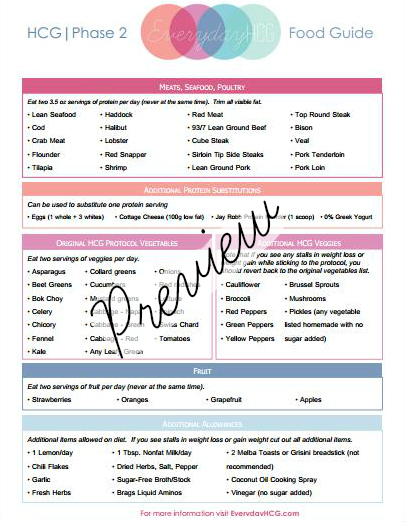The HCG diet is a popular weight loss plan that is divided into different phases. Each phase has its own specific guidelines and recommended foods. In this post, we will discuss the HCG diet plan for Phase 1 and provide you with a comprehensive list of approved foods.
Phase 1: The Loading Phase
Phase 1, also known as the “loading phase,” is the first stage of the HCG diet. During this phase, individuals are encouraged to consume high-calorie, high-fat foods to build up their body’s fat reserves. This might seem counterintuitive for a weight loss plan, but the idea is that by increasing your calorie intake, the HCG hormone will be able to target and burn excess fat more effectively during the next phase.
 Some of the approved foods for Phase 1 include:
Some of the approved foods for Phase 1 include:
- Fatty cuts of meat like bacon, sausages, and ribeye steak
- Full-fat dairy products such as butter, cheese, and cream
- Oils and fats like coconut oil, olive oil, and avocados
- High-calorie snacks like nuts, seeds, and chocolate
- Grains and starches like pasta, bread, and rice
- Sugary treats like ice cream and pastries
It’s important to note that while you are encouraged to indulge in these high-calorie foods, it’s still essential to listen to your body and not overeat to the point of discomfort. This phase typically lasts for two days.
Phase 2: The Weight Loss Phase
After completing Phase 1, it’s time to move on to Phase 2, also known as the “weight loss phase.” During this phase, individuals restrict their calorie intake to around 500-800 calories per day while receiving daily injections or oral doses of HCG hormone. The combination of calorie restriction and HCG is believed to help reset the body’s metabolism and promote fat burning.
 Here’s a sample menu for Phase 2:
Here’s a sample menu for Phase 2:
Breakfast:
 For breakfast, you can have a cup of unsweetened tea or coffee, along with one serving of fruit like an apple or orange. You can also include a protein source like boiled eggs or cottage cheese.
For breakfast, you can have a cup of unsweetened tea or coffee, along with one serving of fruit like an apple or orange. You can also include a protein source like boiled eggs or cottage cheese.
Lunch:
 For lunch, you can have a lean protein source like chicken breast or fish, along with a serving of vegetables like spinach or tomatoes. You can also include a small portion of whole grains like quinoa or brown rice.
For lunch, you can have a lean protein source like chicken breast or fish, along with a serving of vegetables like spinach or tomatoes. You can also include a small portion of whole grains like quinoa or brown rice.
Snack:
 For a snack, you can have a handful of almonds or a serving of Greek yogurt.
For a snack, you can have a handful of almonds or a serving of Greek yogurt.
Dinner:
 For dinner, you can have another lean protein source like lean beef or tofu, along with a variety of low-calorie vegetables like broccoli or zucchini.
For dinner, you can have another lean protein source like lean beef or tofu, along with a variety of low-calorie vegetables like broccoli or zucchini.
Throughout Phase 2, it’s crucial to stay hydrated and drink plenty of water. Additionally, it’s recommended to avoid any added sugars, processed foods, and high-fat meals.
By following the HCG diet plan, individuals can significantly reduce their caloric intake while promoting fat loss. It’s important to consult with your healthcare provider or a registered dietitian before starting any new diet plan, especially if you have any underlying health conditions.
In conclusion, the HCG diet is a weight loss plan that consists of different phases, including the loading phase and the weight loss phase. During Phase 1, individuals consume high-calorie, high-fat foods to build up their body’s fat reserves. In Phase 2, individuals restrict their calorie intake and receive HCG hormone doses to promote fat burning. By following the approved food list and guidelines for each phase, individuals can achieve their weight loss goals effectively.